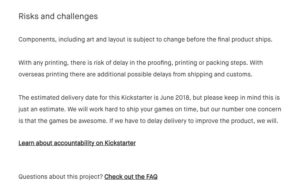While Kickstarter may be the best place for publishers to nurture a game idea into existence, it presents some challenges for consumers. Instead of a simple store listing and a “Pre-Order” now button right next to the product image, Kickstarter gives creators a huge amount of visual real estate to craft their pitch.
Here’s the catch, not all Kickstarter projects turn out well; or at all. I know. I hate to be the bearer of the bad news, but sometimes a project just isn’t all that a creator promises. It has gotten better, and creators are more aware of timelines and schedules now, but there are still some times when it’s better to not back at all.
Want some tips to identify those times? Sure you do!
Caveat 1: How much experience do the creators have?
 One of the immediate things I do to take stock of what I’m about to get into is to check out the Risks and Challenges section. What kind of projects has the creator run before? With regards to board games, do they have a reputable manufacturing, shipping, and fulfillment partner? Also, how much experience, overall, do they have in business? Even a brand new creator on Kickstarter is essentially starting a company, so it’s good to know how competent they are at doing business. Why? Because Kickstarter is really a storefront for new ideas.
One of the immediate things I do to take stock of what I’m about to get into is to check out the Risks and Challenges section. What kind of projects has the creator run before? With regards to board games, do they have a reputable manufacturing, shipping, and fulfillment partner? Also, how much experience, overall, do they have in business? Even a brand new creator on Kickstarter is essentially starting a company, so it’s good to know how competent they are at doing business. Why? Because Kickstarter is really a storefront for new ideas.
Caveat 2: Does the game repeat the theme and mechanisms of another recent game in existence?
This is pretty easy to research for common themes and mechanisms, but for obscure concepts, you might have to do a little digging. If a game has been released less than three years ago with the same theme and mechanisms, why did that game do well or what did that game do poorly? This will also help you evaluate for yourself whether a new game (which won’t be delivered soon) is going to add to the overall glut of games in the market right now, or whether it will truly be able to do something different.
Caveat 3: What stage are you at with regards to game collecting? Growth or Status Quo?
 Go back a few years with me, and you might see a different mindset with regards to collecting games. I was ravenous for any kind of game with a mechanism I hadn’t tried or a theme I didn’t have. There are a bazillion games available for purchase right now. A new game stays in the market for roughly 2-3 years depending on the print run and where it is sold. If you feel you’ll be able to purchase the game at retail after the Kickstarter, then backing is only worth it for the stretch goals or exclusives. However, if the game will never be available after the campaign delivers, then it might be time to take stock of whether or not you’re excited enough to risk the shelf real estate with a new idea.
Go back a few years with me, and you might see a different mindset with regards to collecting games. I was ravenous for any kind of game with a mechanism I hadn’t tried or a theme I didn’t have. There are a bazillion games available for purchase right now. A new game stays in the market for roughly 2-3 years depending on the print run and where it is sold. If you feel you’ll be able to purchase the game at retail after the Kickstarter, then backing is only worth it for the stretch goals or exclusives. However, if the game will never be available after the campaign delivers, then it might be time to take stock of whether or not you’re excited enough to risk the shelf real estate with a new idea.
Caveat 4: Are the stretch goals meaningful?
Sometimes, creators don’t have much creativity or cost flexibility when creating stretch goals. Getting the overall product to a certain shipping weight may limit what can be provided. In addition, just adding premium pieces might add more weight without attracting more backers. Know up front what stretch goals matter to you by taking a look at a friend’s Kickstarter delivery and see if the originally planned components are good enough for the game or whether the added content really makes the experience better.
Caveat 5: Does the game have a long list of Stretch Goals and present those first on the page?
This is a personal choice for some, but my recommendation for newbies to Kickstarter is to stay as far away from these campaigns as possible unless they’re from a company with a strong history. CMON is a company that has a reputation for successfully delivering such projects. A first (or even second) project company may not know what they’re getting into. Also, this tactic of showing stretch goals first is precisely designed to get as many backers as quickly as possible. It’s really hard to evaluate if they care about the end product or if they only care about sales. My advice, tread VERY carefully with these, and when in doubt, be prepared to not receive the project on time or with reduced overall quality.
Hopefully following this list you’ll save yourself some overall grief. If a company committed one of these errors, let us know in the comments and how it all turned out!





















